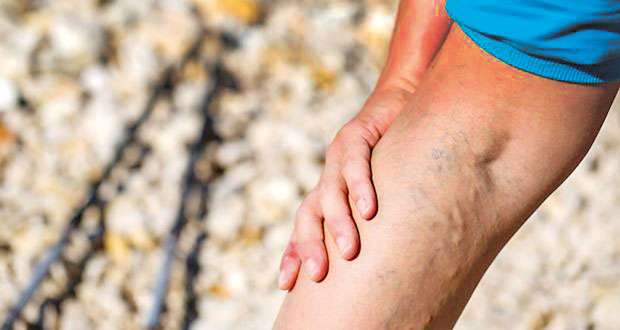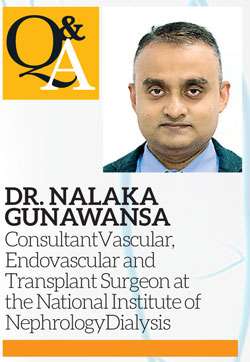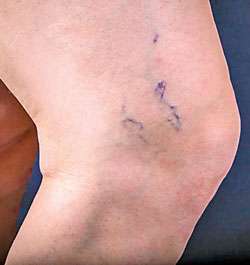Reply To:
Name - Reply Comment

Occasionally, the varicose veins can burst due the high pressure within. This is rare, but can be quite dramatic
Veins are responsible for returning blood from the legs back to the heart
If you can control weight and avoid being overweight, it definitely helps in minimizing the chance of recurrence
In this week’s Health capsule we take a close look at quite a common hazard among people which is Varicose Veins. Following are some of the most common questions which are asked regarding this topic.
Q What are Varicose Veins?

These valves make sure that the blood in the veins, go back up rather than falling down by gravity. However, in the disease called varicose veins, these valves become non-functional. This results in more and more blood being pulled down in to the legs and stagnating in the veins of the lower legs rather than being moved to the heart. When this happens over a long period of time, it results in pooling of blood and increase of pressure in these veins causing them to get larger, tortuous and ballooned out. This process is called varicose veins.
Q What causes this condition?
The commonest reason for this is actually a genetic tendency (hereditary or familial). In fact approximately 30% of those suffering from varicose veins have someone in the family who has this condition and it tends to be hereditary.
In addition, being overweight also causes veins to weaken and results in varicose veins.
Pregnancy can be the cause for varicose veins due to the extra pressure on the leg veins due to the baby within as well as the effects of increased oestrogen levels during pregnancy. If you stand a lot during your daily routine, this also results in a higher tendency to develop varicose veins

Q Is varicose veins more common among females? Is it related to the use of high heeled foot wear?
Actually 60% of those who develop symptomatic varicose veins are females. However, males also develop this condition fairly commonly and account for 40% of those who have it. The use of high-heeled shoes actually has no definitively proven connection to the development of varicose veins.
Q Is there a connection between age and this condition?
Yes, the most common age group to develop this condition comprise those between the ages 40-50. However, especially in those who might have a family history of varicose veins, the condition can actually surface even around the age of 20 years or earlier.
Q What is varicose veins laser treatment?
Laser treatment is one of the latest additions to the treatment armamentarium for varicose veins. Up until about 20 years ago, all we had was open surgery. Now we have laser and radio frequency methods. The advantages of these newer methods are numerous:
Q Can you develop varicose veins after laser treatment?
Well, approximately 20-25% of varicose veins tend to return regardless of what treatment is administered. This is especially so in those who have a family history of varicose veins or those who are overweight. However, the great majority (approximately 75%) do not return. Even the ones who do return after appropriate laser treatment are often quite small in number and much easier to treat with simple methods like injections. Therefore it is always advisable to get the appropriate treatment at the correct time.
Q Can a person stay without treatment? Wh at are the risks?
at are the risks?
Well, most varicose veins do not give any symptoms at first apart from the cosmetic disfigurement. Actually the first symptoms of varicose veins are the heaviness and pain in the legs. This is especially so when standing for long periods. The patient would typically feel tiredness or pain in the legs after standing for a few hours or after a day of work towards the late afternoon or evening.
Thereafter, the skin over the ankle area gets discoloured and brown due to the stagnating ‘dirty’ blood. The skin also starts to be itchy.
The next stage is that the resulting damaged skin breaks forming an ulcer or wound. At this stage the treatment is complicated. It often requires repeated bandaging for periods up to 6 months to heal. Once the ulcer is healed a definitive treatment is required in order to avoid the wounds from returning.Occasionally, the varicose veins can burst due to the high pressure within. This is rare, but can be quite dramatic. It can happen without any prior warning or pain, often happening when you least expect it. If it does happen, we advise the patient to apply a tight bandage or dressing over the area of bleeding and seek medical advise immediately.
Q What are the precautions to take after treatment?
Once treatment is complete, a few simple things can sometimes reduce the chance of varicose veins from returning. If possible, one must limit the duration of time they are on their feet. However, this may not be practical depending on the occupation or household work that one does.Something that all of us can do is control body weight. If you can control weight and avoid being overweight, it definitely helps in minimizing the chance of recurrence.
(The writer is a Consultant Vascular, Endovascular and Transplant Surgeon, at the National Institute of Nephrology Dialysis and Transplantation and the National Hospital of Sri Lanka)